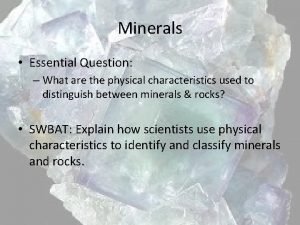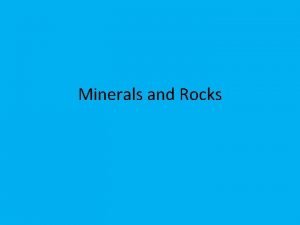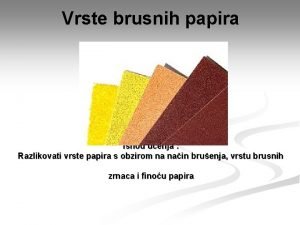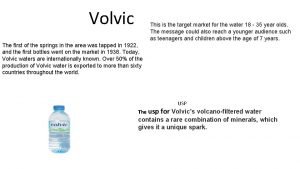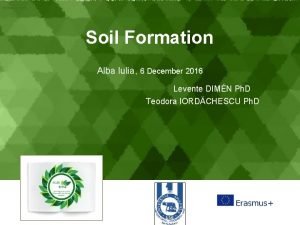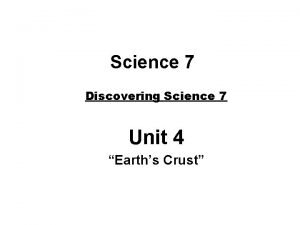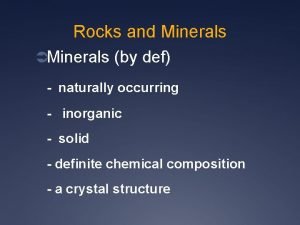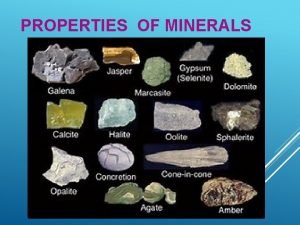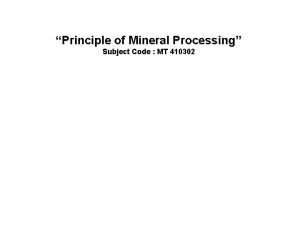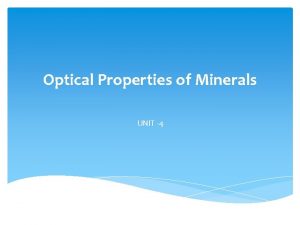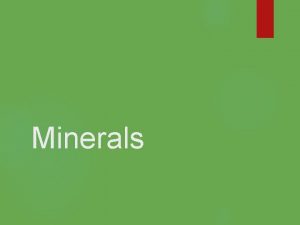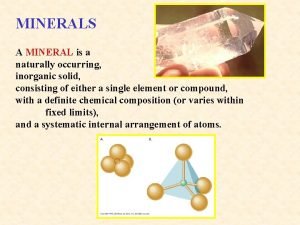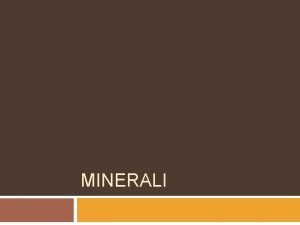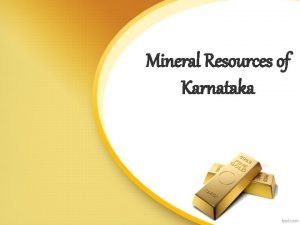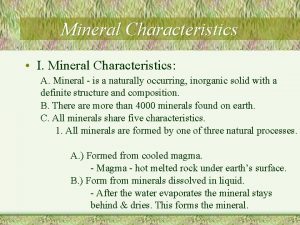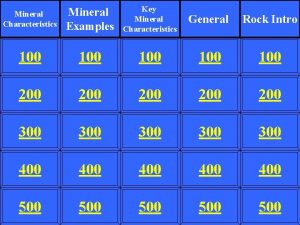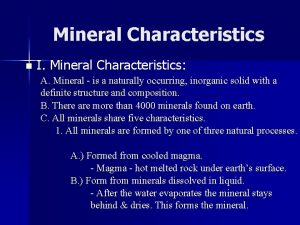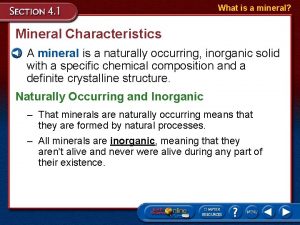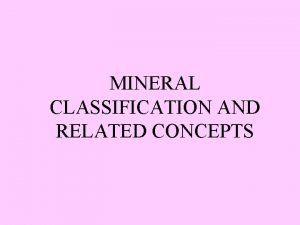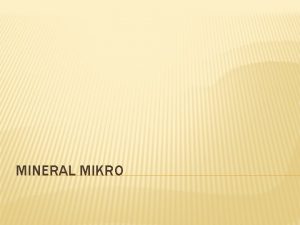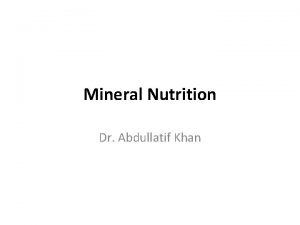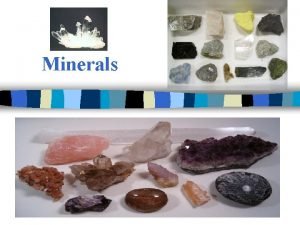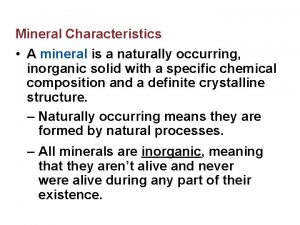What is a mineral Mineral Characteristics A mineral














- Slides: 14

What is a mineral? Mineral Characteristics • A mineral is a naturally occurring, inorganic solid with a specific chemical composition and a definite crystalline structure. Naturally Occurring and Inorganic – That minerals are naturally occurring means that they are formed by natural processes. – All minerals are inorganic, meaning that they aren’t alive and never were alive during any part of their existence.

What is a mineral? Mineral Characteristics Solids with Specific Compositions – All minerals are solids with definite shapes and volumes. – Each type of mineral has a chemical composition unique to that mineral. – Although a few minerals, such as copper, silver, and sulfur, are composed of single elements, the vast majority are made from compounds. – In some minerals, chemical composition may vary within a well-defined range.

What is a mineral? Mineral Characteristics Definite Crystalline Structure – The atoms in minerals are arranged in regular geometric patterns that are repeated again and again. – A crystal is a solid in which the atoms are arranged in repeating patterns.

What is a mineral? Mineral Characteristics Definite Crystalline Structure – At times and fairly rare, a mineral will form in an open space and grow into one large crystal, possibly taking the shape of one of the six major crystal systems. Tetragonal Cubic Orthorhombic Hexagonal Monoclinic Triclinic

Identifying Minerals Mineral Identification Color – One of the most noticeable characteristics of a mineral is its color. – Color is sometimes caused by the presence of trace elements or compounds within a mineral. – In general, color is one of the least reliable clues to a mineral’s identity.

Identifying Minerals Mineral Identification Luster – Luster is the way that a mineral reflects light from its surface. – Luster is described as being either metallic or nonmetallic. – Metallic luster describes shiny surfaces that reflect light like the chrome trim on cars. – Nonmetallic luster might be described as dull, pearly, waxy, or silky. – Differences in luster are caused by differences in the chemical compositions of minerals.

Identifying Minerals Mineral Identification Texture – Texture describes how a mineral feels to the touch. – The texture of a mineral might be described as smooth, rough, ragged, greasy, soapy, or glassy. Streak – Streak is the color of a mineral when it is broken up and powdered. – Sometimes, a mineral’s streak does not match the mineral’s external color. – A mineral’s streak rarely changes, even if it is weathered or its external color varies slightly.

Identifying Minerals Mineral Identification Hardness – Hardness is one of the most useful and reliable tests for identifying minerals. – Hardness is a measure of how easily a mineral can be scratched. – German geologist Friedrich Mohs developed a scale in which an unknown mineral’s hardness can be compared to the known hardnesses of ten minerals. – Any mineral with a greater hardness than another mineral will scratch that softer mineral.

Identifying Minerals Mineral Identification Hardness

Identifying Minerals Mineral Identification Cleavage and Fracture – Minerals break along planes where atomic bonding is weak. – Cleavage is the ability of a mineral to split relatively easily and evenly along one or more flat planes. – To identify a mineral by cleavage, geologists count the number of cleaved planes and study the angle or angles between them. – Fracture is the ability of minerals to break with arclike, rough, or jagged edges.

Identifying Minerals Mineral Identification Density and Specific Gravity – Differences in weight are the result of differences in density, which is defined as mass per unit of volume. – Density is expressed as a ratio of the mass of a substance divided by its volume, or D = M/V. – Density reflects the atomic weight and structure of a mineral. – The most common measure of density used by geologists is specific gravity. – Specific gravity is the ratio of the weight of a substance to the weight of an equal volume of water at 4°C.

Identifying Minerals Special Properties • Special properties of minerals also can be used for identification purposes. – Double Refraction – Fizz – Magnetism – Odor – Radioactivity

Identifying Minerals Mineral Uses Ores – An ore is a mineral that contains a useful substance that can be mined at a profit. – Examples of ores include Hematite, which contains the element iron and bauxite, which contains the element aluminum.

Identifying Minerals Gems • Gems are valuable minerals that are prized for their rarity and beauty. • Gems such as rubies, emeralds, and diamonds are cut, polished, and used for jewelry. • In some cases, the presence of trace elements can make one variety of a mineral more colorful and thus more prized than other varieties of the same mineral.
 Characteristics of minerals
Characteristics of minerals Special minerals
Special minerals Vrednostni papir besednjak
Vrednostni papir besednjak Evian target market
Evian target market Showeet
Showeet Rock vs mineral
Rock vs mineral Minerals def
Minerals def Properties of minerals
Properties of minerals 2 product formula mineral processing
2 product formula mineral processing Resemisasi
Resemisasi Symmetrical extinction of minerals
Symmetrical extinction of minerals A narrow channel or slab of a mineral
A narrow channel or slab of a mineral Mineral vs element
Mineral vs element Mohsova trdotna lestvica
Mohsova trdotna lestvica Mineral resources of karnataka
Mineral resources of karnataka
